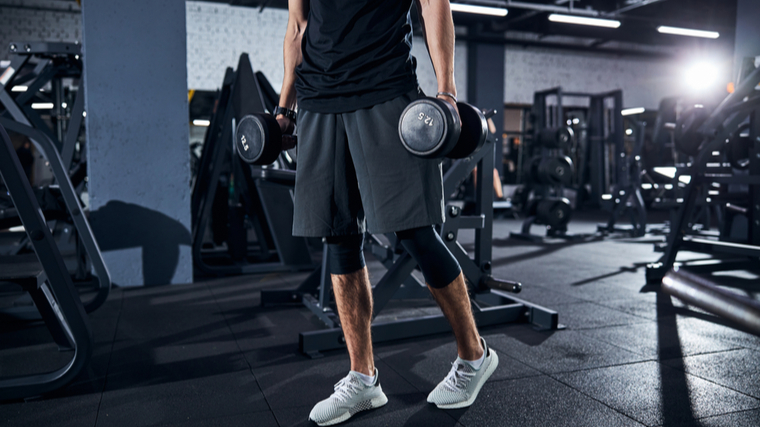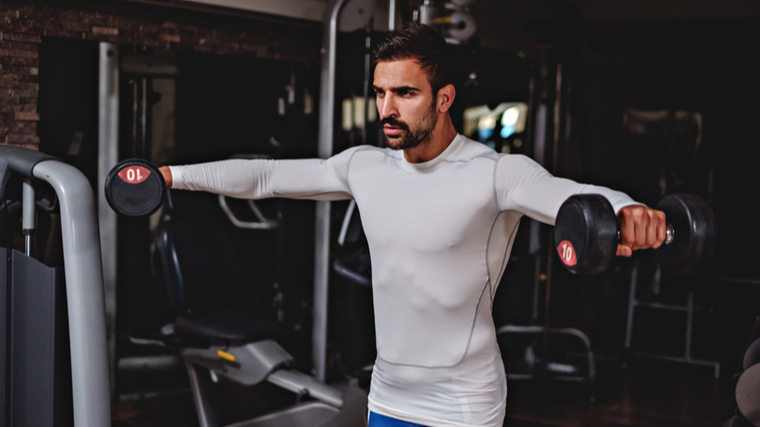There are few muscles that are exemplary both in a t-shirt and on the beach, but an impressive pair of deltoids are one of them. The lateral raise can be tricky to perfect, but, when mastered, becomes the cornerstone of a boulder-shoulder aesthetic. While visually straightforward, there are subtle tidbits that can greatly improve your results and help you craft massive delts that both look good and perform powerfully.
In this article, we’ll go over everything you need to know to perfect your lateral raise.
- How to Do the Lateral Raise
- Benefits of the Lateral Raise
- Who Should Do the Lateral Raise
- Lateral Raise Programming Recommendations
- Lateral Raise Variations
- Lateral Raise Alternatives
- Frequently Asked Questions
How to Do the Lateral Raise
The lateral raise looks as easy as grabbing a pair of dumbbells and lifting them away from your body, but the shoulder is a complex piece of biological machinery. By following these steps, you can most effectively isolate the middle deltoid for even faster muscle gains.
Step 1 — Stand Tall
Stand tall or shift the hips back ever so slightly (using a hip hinge). Take a neutral grip on the dumbbells and bend the arm just enough to keep the elbow joint from being fully locked out. Instead of tucking your arm at your side, allow it to drift forward slightly. Brace your legs, core, and trunk to provide preliminary stability.

Coach’s Tip: A slight inclination of the torso will extend the range of motion that the shoulder goes through while performing the lateral raise.
Step 2 — Raise the Weights
Keep your palms facing your body with a neutral grip and raise the dumbbells until your arms are roughly parallel to the ground.

Stop just before the dumbbells elevate higher than your clavicles.
Coach’s Tip: Try to keep your shoulder depressed as you lift the weight — shrugging during the movement may cause the traps to take over too much.
Step 3 — Reset and Repeat
If possible, pause for a brief moment at the top of the repetition. This will create an additional stability demand and increase the challenge of the movement.

Lower the dumbbells under control to avoid loss of position or the addition of momentum between repetitions.
Coach’s Tip: As the weights return to the starting position, tension on the deltoid dramatically decreases. You may want to stop short of your original position to ensure the middle delt is under load at all times.
Benefits of the Lateral Raise
Though commonly viewed as a physique-focused exercise, the benefits of the lateral raise extend beyond that of muscle hypertrophy. When performed well, the lateral raise also improves shoulder health, reinforces proper bracing and stability, and teaches the user to isolate individual muscle groups.
Muscle Hypertrophy
The most readily apparent benefit of the lateral raise is the ability to target the middle aspect of the shoulder. While many exercises have synergy with the front and rear deltoid to complement their growth, the lateral raise is one of the few exercises that directly targets the part of the shoulder most critical for creating that iconic v-tapered look.
Shoulder Health
Healthy shoulders can perform all ranges of motion without pain or instability. A properly performed lateral raise challenges the stability of the shoulder, particularly in the rotator cuff — thus providing a functional stimulus.
Neglecting one dimension of movement is never wise, and this goes double for a joint like the shoulder that serves so many essential functions both in the gym and in everyday life.
Bracing and Stability
The lateral raise requires precise posture and bracing to ensure the middle deltoid is being trained as effectively as possible. Engaging the posterior chain and bracing the trunk in the lateral raise can reinforce the ability to stabilize and brace in other muscle-building and barbell exercises as well.
Targeted Muscle Growth
Isolating specific muscles is the name of the game when it comes to forging an impressive body. The shoulder being composed of three small but distinct regions forces the trainee to consistently adhere to proper technique to single out the sliver of muscle that they’re specifically trying to target. Eliminating momentum, strict positional awareness, and discipline with muscular engagement makes or breaks a successful lateral raise.
Who Should Do the Lateral Raise
The lateral raise is mainly the province of physique athletes, but it shouldn’t be reserved just for them. Gymgoers and athletes can reap some serious benefits by adding the lateral raise to their routine as well.
Physique Athletes
Packing on as much muscle as possible is the goal of professional bodybuilders and physique enthusiasts alike. Without direct attention, an underdeveloped middle deltoid leaves a glaring gap in their shoulder aesthetic. Properly performed lateral raises with a variety of implements are a safe and effective way to slap on a ton of muscle to the otherwise neglected middle deltoid.
New Gymgoers
New gymgoers are often in need of improving many areas of fitness at once. While learning to train the shoulders, going directly to overhead pressing might be too complex or intimidating. On the other hand, light lateral raises could be an early addition to muscle development while prerequisites for more complex shoulder exercises are built up.
Overhead Athletes
Athletes like Olympic lifters or CrossFitters require a great deal of function and stability from their entire shoulder complex. However, they also spend a ton of time taking a beating from high-intensity barbell work. Lateral raises can serve as a low-impact alternative to gaining or maintaining muscle to help them in their overhead exercises without contributing a huge amount of fatigue.
Lateral Raise Programming Recommendations
Given the relatively small size of the middle deltoid and how easy (and sometimes detrimental) added momentum can be, using lighter weights and very strict technique is the key to the lateral raise. Training experience and overall strength levels also help guide programming recommendations.
Beginners
New trainees looking to implement the lateral raise to build their shoulders should stick to lighter weights that allow the middle deltoid to be trained in isolation. This means that they may need to perform higher repetition count sets to keep the tension primarily where they want it and still take the muscle to fatigue. The ability to target the middle deltoid and avoid other larger muscle groups like the traps is often the limiting factor for new trainees.
Perform lateral raises for two to three sets of 15-20 repetitions. Shoot for a burn across the middle deltoid and difficulty reaching full range of motion as a sign that you’re reaching fatigue.
Intermediates
Intermediate trainees have likely developed a sense of mind-muscle connection. Their ability to isolate their middle deltoid has improved, but along the way so has the strength of their pesky synergists looking to hog all the tension. If you have some time in the gym under your belt, focus on a moderate weight for moderate repetitions and higher set counts.
Perform lateral raises for three to four sets of 12-15 repetitions with slightly heavier weights, focusing on a controlled eccentric and explosive change of direction at the bottom.
Advanced Trainees
Advanced trainees likely have developed a strong ability to isolate their middle deltoid and have accumulated enough training experience that frequency of performing the lateral raise becomes a huge asset in their development. If you’ve got a lot of gym experience, you likely need to be intense and creative with your shoulder training to keep making progress.
Perform the lateral raise for 3-4 sets of 10-12, 12-15, or 20+ repetitions three or even four times per week. Overall soreness and slower recovery of strength are good indicators of when to pull back or if you can continue with relatively high frequency.
Lateral Raise Variations
Lateral raise variations can involve either changing the implement — from dumbbells to cables or machines — or assuming different starting positions to challenge the muscle.
Cable Lateral Raise
The cable lateral raise can be performed either one arm at a time or with both arms working together. The adjustability of the handle height as well as constant resistance provided by the cable itself make for a devilishly effective stimulus without requiring you to re-learn a new technique.
Lateral Raise Machine
Several versions of a lateral raise machine exist with pads that rest on the forearms. The machine helps stabilize the range of motion and make it easy to quickly adjust the load being used, making them great for high-intensity training techniques.
Incline Bench Lateral Raise
Since gravity only works straight down, you sometimes have to get creative about how you perform exercises like the lateral raise. By setting an adjustable bench to a high incline and lying on your side against it, the resistance curve of the lateral raise is significantly altered, providing a fresh stimulus for growth.
Lateral Raise Alternatives
The lateral raise is a high value exercise that delivers stimulus directly to the middle deltoid like few other exercises can. However, that doesn’t mean it is the only tool in the toolbox for targeting the muscle. In a pinch, some other movements can get the job done if necessary.
Cable Upright Row
Upright rows target the middle deltoid and traps, but can also be difficult to perform comfortably and effectively. Performing the upright row with a rope attachment allows for a good deal of range motion, convenient loadability, and maximum comfort on the wrists and elbows.
Arnold Press
Named for bodybuilding legend Arnold Schwarzenegger, the Arnold press is an overhead press variation that involves more dynamic movement at the shoulder. By rotating the dumbbells from the front of the body around to the sides as you press, the middle deltoid can get a bit of love as a secondary mover during part of the range of motion.
Wrapping Up
When it comes to training, there are usually more than a few ways to skin a cat. Quad development can be achieved with almost any movement or implement, and there are dozens of great bicep curl variations for building big peaks.
But when it comes to building cannonball-sized delts and creating a tapered torso, the lateral raise is one of the most uniquely essential exercises out there. Almost nothing creates width in the upper body more than a properly executed lateral raise — and the results will speak for themselves.
Frequently Asked Questions
For anything involving the shoulders, there are bound to be a slew of questions swirling around since the joint is so articulate. If you’re worried about the safety of the lateral raise or curious about how to get the most from it, we’ve got you covered.
Is the lateral raise safe to perform?
Yes! No exercise is inherently dangerous. If you have an acute or chronic injury, it is best to consult with a licensed professional before getting into any resistance training. However, if you’re healthy and able, the lateral raise is a perfectly safe movement when performed properly.
How often can I do lateral raises?
Simply put, your “training age,” or experience in the gym, will dictate your frequency. If you’re just starting out, once or twice a week is plenty of stimulation for such a small muscle. Over time, though, you may find you need to kick up the frequency to keep seeing gains.
How heavy should I lift on lateral raises?
The medial deltoid is a small muscle with a precise, delicate function of abducting the shoulder. As such, it doesn’t require mountainous loads the way the lats or hamstrings sometimes do. Since precision is key and the exercise is easy to “cheat” on, lighter weights and a focused contraction is the play to make.
Featured Image: Prostock-studio / Shutterstock